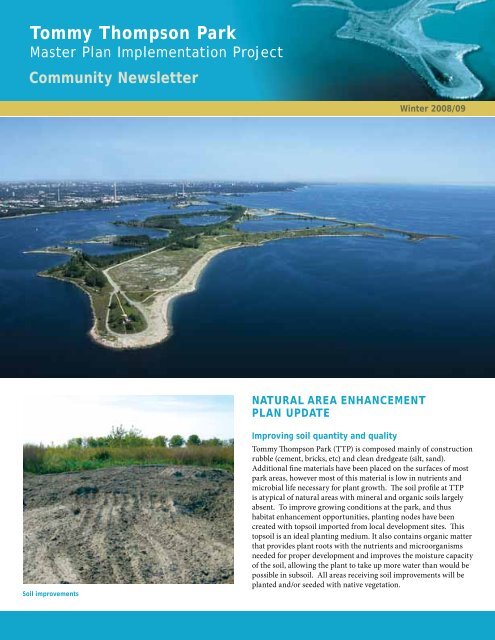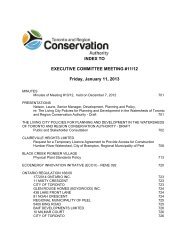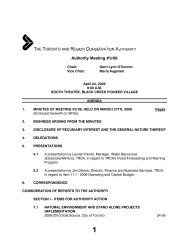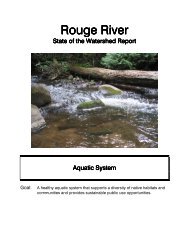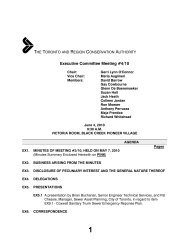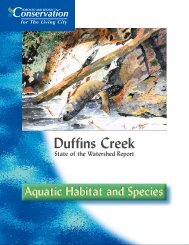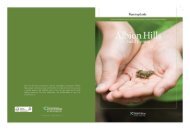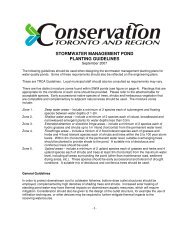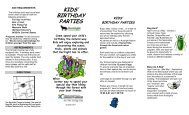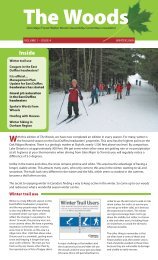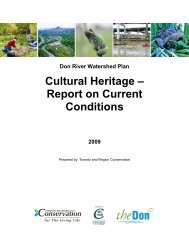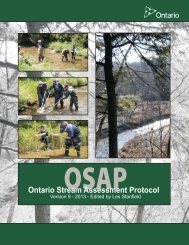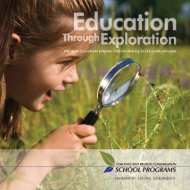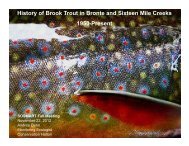Create successful ePaper yourself
Turn your PDF publications into a flip-book with our unique Google optimized e-Paper software.
<strong>Tommy</strong> <strong>Thompson</strong> <strong>Park</strong><br />
Master Plan Implementation Project<br />
Community Newsletter<br />
<strong>Winter</strong> <strong>2008</strong>/<strong>09</strong><br />
NATURAL AREA ENHANCEMENT<br />
PLAN UPDATE<br />
Soil improvements<br />
Improving soil quantity and quality<br />
<strong>Tommy</strong> <strong>Thompson</strong> <strong>Park</strong> (TTP) is composed mainly of construction<br />
rubble (cement, bricks, etc) and clean dredgeate (silt, sand).<br />
Additional fine materials have been placed on the surfaces of most<br />
park areas, however most of this material is low in nutrients and<br />
microbial life necessary for plant growth. The soil profile at TTP<br />
is atypical of natural areas with mineral and organic soils largely<br />
absent. To improve growing conditions at the park, and thus<br />
habitat enhancement opportunities, planting nodes have been<br />
created with topsoil imported from local development sites. This<br />
topsoil is an ideal planting medium. It also contains organic matter<br />
that provides plant roots with the nutrients and microorganisms<br />
needed for proper development and improves the moisture capacity<br />
of the soil, allowing the plant to take up more water than would be<br />
possible in subsoil. All areas receiving soil improvements will be<br />
planted and/or seeded with native vegetation.
<strong>Tommy</strong> <strong>Thompson</strong> <strong>Park</strong> Community Newsletter — <strong>Winter</strong> <strong>2008</strong>/<strong>09</strong><br />
2<br />
Fall plantings<br />
More than 600 native trees and shrubs were installed in fall <strong>2008</strong><br />
in various areas around the park. Clusters of trees and shrubs were<br />
strategically planted in the meadow areas along the Neck to help<br />
buffer strong winds off the lake and provide habitat for butterflies<br />
and other meadow species. The young conifer trees were wrapped<br />
in burlap to improve their survival as the winter conditions on the<br />
waterfront can be very harsh on young vegetation. The area around<br />
Triangle Pond received several planting treatments: shrub thickets<br />
containing a variety of native species were installed on the east<br />
side of the pond; conifer nodes containing Eastern white-cedar,<br />
white spruce and white pine were created on both the east and<br />
west sides; and deciduous trees were planted throughout the area.<br />
These new plantings improve the diversity of vegetation at TTP and<br />
enhance wildlife habitat by providing food and cover, as well as<br />
overwintering and nesting habitat.<br />
Raptor perches<br />
As the remaining non-functioning light standards in the park are<br />
removed there are fewer areas for raptors to perch. Raptors, such<br />
as the Red-tailed Hawk, perch to rest and survey the surrounding<br />
areas for foraging opportunities. To help compensate for the lack of<br />
perching locations TRCA staff installed a raptor pole in a meadow<br />
area near Embayment D early this winter. The pole, including a<br />
snake hibernaculum at the base, stands approximately 7 metres<br />
tall and is expected to become a favourite location for park visitors<br />
looking for birds of prey. Additional raptor poles will be installed in<br />
the park throughout the coming months. Already a Peregrine Falcon<br />
(listed as Threatened by COSSARO and a Special Concern Species by<br />
COSEWIC) is enjoying this new vantage point.<br />
Embayment A habitat enhancements<br />
Embayment A is the most westerly embayment of the park<br />
and can be generally characterized as cool water habitat with<br />
smaller areas of coastal wetland. Habitat enhancements will<br />
take place this winter to increase primary production, expand<br />
coastal wetlands and improve physical and thermal refuge areas<br />
for fish and reptiles. Work will include surcharging a section<br />
of the embayment with clean sand dredgeate and installing<br />
rock shoals, anchored logs and woody stumps to improve the<br />
structural diversity of the nearshore area and shoreline. Small<br />
islands, backwater lagoons and isolated wet pockets will be<br />
created and planted this spring with aquatic and riparian<br />
vegetation. These features provide a variety of habitats for<br />
wildlife offering specific benefits to fish, invertebrates, reptiles<br />
and waterfowl. A temporary staging area for the materials for<br />
this project has been placed across from the Embayment and<br />
will be restored upon the completion of the Embayment A<br />
habitat enhancement project.<br />
Colonial waterbird habitat enhancements<br />
Colonial birds are those that typically nest in large<br />
congregations or in colonies. TTP currently has seven species<br />
of breeding colonial waterbirds, which contribute to its<br />
designation as an internationally recognized Important Bird<br />
Area (IBA). Three of these species, Double-crested Cormorant,<br />
Black-crowned Night-heron and Great Egret, typically nest in<br />
trees and over time as trees begin to die and eventually fall,<br />
they are no longer available as tree nesting habitat. Trees die in<br />
waterbird colonies, especially cormorant colonies, largely due to<br />
the deposition of excrement and branch stripping. In areas<br />
Peregrine Falcon on new raptor pole<br />
Photo courtesy of: Ian Sturdee, TTPBRS volunteer<br />
Boreal Owl<br />
Photo courtesy of: Ian Sturdee, TTPBRS volunteer
<strong>Tommy</strong> <strong>Thompson</strong> <strong>Park</strong> Community Newsletter — <strong>Winter</strong> <strong>2008</strong>/<strong>09</strong><br />
3<br />
where cormorants nest, forest conditions range from virtually<br />
none remaining on Peninsula A to mostly dead standing<br />
trees on Peninsula B to a declining forest on Peninsula C.<br />
Cormorants appear adaptable to the loss of forest and have<br />
begun to nest on the ground where the trees used to stand;<br />
however night-herons and egrets will not readily ground nest<br />
and will likely leave the site if their nesting habitat is no longer<br />
suitable. The increasing cormorant population also competes<br />
with night-herons and egrets for nesting sites.<br />
In order to maintain the populations of all tree nesting colonial<br />
bird species at TTP, TRCA has initiated habitat improvements<br />
to encourage cormorants to nest on the ground and improve<br />
tree and shrub cover for the benefit of night-herons and egrets.<br />
By promoting cormorant ground nesting, staff hope to alleviate<br />
pressure on the remaining forest and reduce competition<br />
for tree nesting sites with night-herons and egrets. Habitat<br />
enhancements to ground nesting sites include the placement of<br />
vertical structure and fallen nest material. Formerly forested<br />
areas that are no longer used for nesting, as well as sparsely<br />
forested areas adjacent to current nesting areas, will be restored<br />
or enhanced in spring 20<strong>09</strong>. Restoration activities will include<br />
soil improvements, placement of woody material and native<br />
tree and shrub planting. While these areas will not provide<br />
immediate colonial waterbird nesting habitat, they will in the<br />
future and, in the meantime, will provide direct habitat for a<br />
variety of other flora and fauna.<br />
NOTABLE WILDLIFE SIGHTINGS<br />
<strong>Tommy</strong> <strong>Thompson</strong> <strong>Park</strong> had some significant, and even unusual,<br />
wildlife sightings for the later half of <strong>2008</strong>. A Northern Hawk<br />
Owl was a late fall visitor to the park – this species is not even on<br />
the TTP Bird Checklist! At least one Boreal Owl has also been<br />
observed in late fall and early winter. Late fall also saw Purple<br />
Sandpipers at TTP - they are considered “accidental” visitors to<br />
the area. More recently Harlequin Ducks, Horned Grebes, and<br />
King Eiders have been sighted in the waters around the park.<br />
These are species that are typically found in higher latitudes<br />
or along ocean coasts. An adult Bald Eagle, White-winged<br />
Crossbills and Common Redpolls are also recent sightings. Of<br />
course, observations of coyote, mink, muskrat, cottontail and<br />
signs of smaller critter continue and are sometimes made even<br />
more obvious in the snow.<br />
TTP NEWS<br />
New TTP website launched<br />
The <strong>Tommy</strong> <strong>Thompson</strong> <strong>Park</strong> website has a new look<br />
and feel and loads more content! The new site was<br />
developed by TRCA staff and designed by iMobileWeb.<br />
Among the new features are details on Master Plan<br />
implementation, habitat restoration and monitoring<br />
activities, resident wildlife, downloadable pdfs, a photo<br />
gallery and much more!<br />
New Peterson Field Guide launched<br />
In September Lee Allen Peterson visited Toronto to<br />
promote the new Peterson Guide to Birds of North<br />
America and to commemorate the centennial of the<br />
birth of his famous and influential father, Roger Tory<br />
Peterson. <strong>Tommy</strong> <strong>Thompson</strong> <strong>Park</strong> hosted Lee Allen<br />
Peterson who visited the park to observe activities at the<br />
<strong>Tommy</strong> <strong>Thompson</strong> <strong>Park</strong> Bird Research Station (TTPBRS),<br />
habitat restoration endeavours and the spectacular<br />
bird colonies. Toronto and Region Conservation staff<br />
were honoured to be included as guest speakers at the<br />
launch event – “Roger Tory Peterson - A Son’s Memories”,<br />
where TTPBRS was featured along with FLAP, before Mr.<br />
Peterson spoke about his life birding with his father.<br />
Conifer node by Triangle Pond
<strong>Tommy</strong> <strong>Thompson</strong> <strong>Park</strong> Community Newsletter — <strong>Winter</strong> <strong>2008</strong>/<strong>09</strong><br />
4<br />
Purple Sandpiper<br />
Photo courtesy of: Ian Sturdee, TTPBRS volunteer<br />
UPCOMING EVENTS<br />
<strong>Winter</strong> Waterfowl Workshop – Saturday, March 7<br />
In addition to the dozens of waterfowl species that inhabit<br />
Toronto’s waterfront year-round, many other waterfowl arrive<br />
during the winter to escape the cold temperatures and limited<br />
food sources of their high north breeding grounds. The open<br />
waters around <strong>Tommy</strong> <strong>Thompson</strong> <strong>Park</strong> provide a refuge from<br />
the extreme conditions in northern Canada. Join TRCA staff on<br />
Saturday, March 7 from 10 a.m. to 12:30 p.m. to learn about<br />
and view these winter visitors. Dress warmly for the outdoors<br />
and bring binoculars and a bird field guide if you have them. The<br />
TTP shuttle van will be running between the front gate and the<br />
viewing station. The event is free, but registration is requested.<br />
To register, call the TTP Hotline at 416-661-6600, ext. 5770<br />
or email ttp@trca.on.ca. In the event of extreme weather<br />
conditions on the day of the event, call the hotline to check<br />
for a notice of cancellation.<br />
Spring Bird Festival – Saturday, May 23<br />
Join us at TTP on Saturday, May 23 from 8 a.m. to 4 p.m. for<br />
the annual Spring Bird Festival. This year we are pleased<br />
to have Dr. Bridget Stutchbury, author of the book Silence<br />
of the Songbirds: How We are Losing the World’s Songbirds<br />
and What We Can Do to Save Them, as our guest speaker<br />
and birdathoner. Activities will include guided hikes,<br />
interpretive displays and children’s activities. Please<br />
check out the TTP website (www.trca.on.ca/ttp) for more<br />
details.<br />
For further information regarding <strong>Tommy</strong> <strong>Thompson</strong> <strong>Park</strong>, please visit www.trca.on.ca/ttpmasterplan<br />
If you have specific questions regarding the project or if you would like to be placed on the project mailing list, please contact:<br />
Catherine DeAbreu<br />
Waterfront Clerk<br />
Telephone: 416-661-6600, ext. 5305<br />
email: cdeabreu@trca.on.ca


